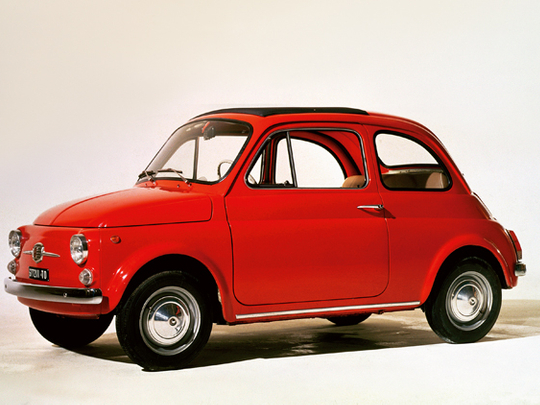
In spite of its tiny proportions, its presence was huge, and it took the world by storm back in the Sixties. And now the Fiat 500, better known as the Cinquecento, is making the headlines again. That’s thanks to a 1971 model, which is going under the hammer next month. But what’s the big deal?
Well, it once belonged to Britain’s Prime Minister David Cameron. The fully restored 500 was purchased by him for his wife as a surprise birthday gift, and remained in the family for more than 10 years. When the bidding begins at the Footman James Classic Motor Show at the NEC in Birmingham, UK, it is expected to fetch around Dh60,000.
Back in the day, it would set you back less than a third of that figure. Produced between 1957 and 1975 as the replacement for the Topolino, the 500 was a city car and available as a two-door coupé or three-door estate. It was so small (2.97 metres long, 1.32 metres wide and 1.32 metres high) that you’d be forgiven for thinking it could fit in your back pocket. That was the appeal — a tiny car for busy streets.
Designed by Dante Giacosa, fitted with a 479cc straight-two motor and mated to a four-speed manual, the 499kg Fiat put Italy on wheels during the Sixties. It was the car of choice, and more than four million units were produced in its 20-year production run, spawning several variants in the process.
Its success was due to the demands of the post-war market that called for economy cars such as the air-cooled rear-engined 500. The four-seater boasted kart-like handling, and though its 18bhp was almost laughable, it could reach a dizzying top speed of 88kph. But most important of all, it boasted incredible economy, sipping just 4.5 litres per 100km. And that’s why Europe fell in love with it.
Sporty models were produced by Abarth and Giannini, but Fiat ceased production of the 500 in 1975 and its replacement, the 126, was launched soon after. This was always going to be received with some scepticism, because of the adulation people had for its predecessor. Today, the diminutive 500 is not only very trendy, but something of a collector’s item. That it endeared itself to millions around the world, speaks volumes for the Cinquecento.











